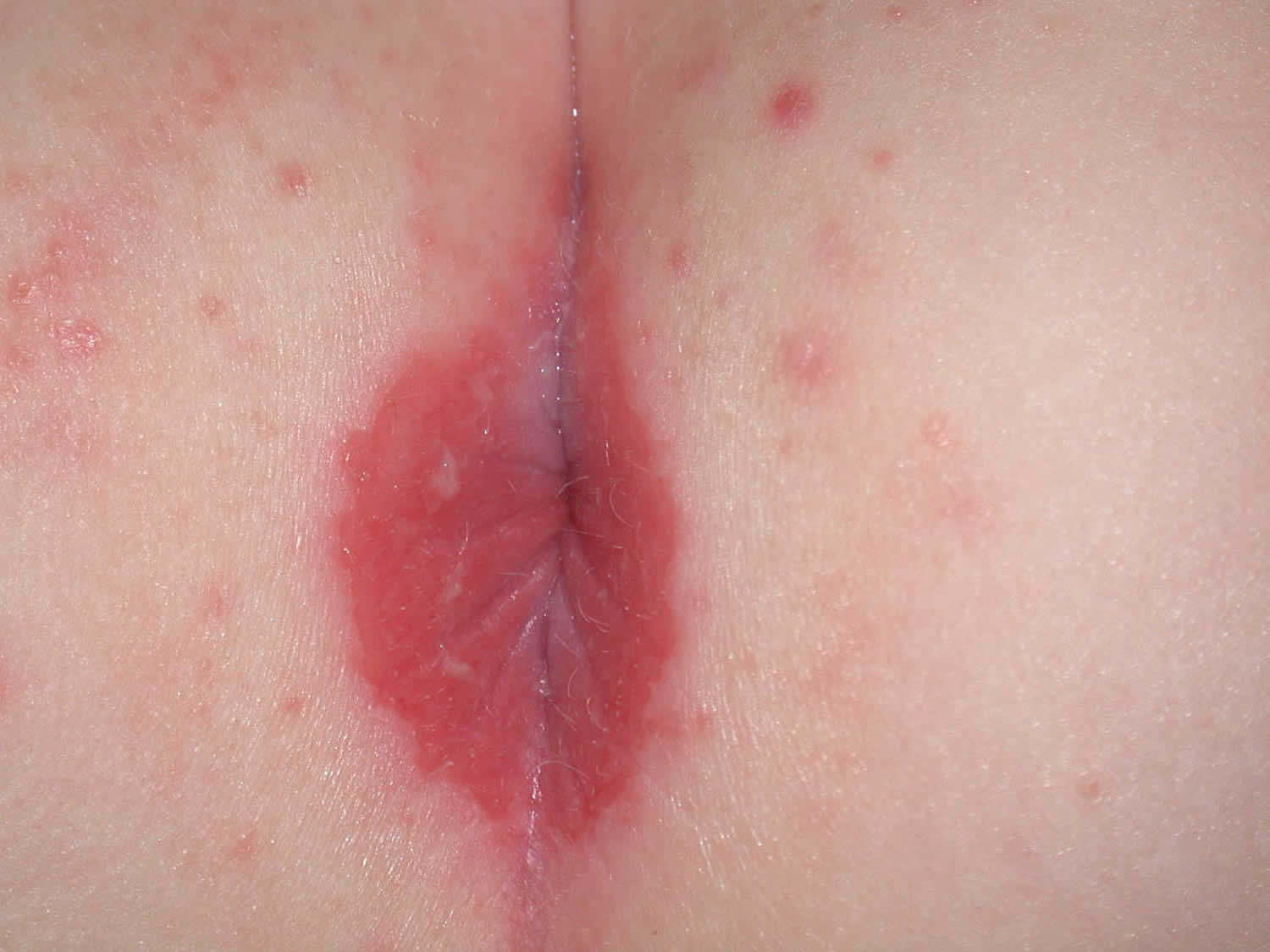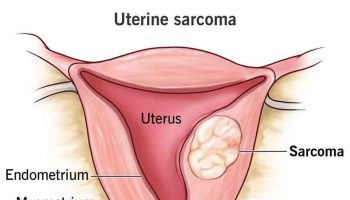Perianal cellulitis
Perianal cellulitis also known as perianal streptococcal dermatitis or perianal streptococcal cellulitis, is an infectious condition of the skin around the anus in children between the ages of 6 months and 10 years old 1. Males are more commonly affected than females with a ratio between 3 to 1 and 2 to 1. Interestingly, children are more commonly affected in the winter and spring months. While perianal streptococcal dermatitis is typically thought to be a pediatric disease, there have been case reports in adults 2. Perianal cellulitis is mostly caused by group A beta-hemolytic streptococcus bacteria 3. Perianal streptococcal dermatitis classically presents as a sharply demarcated redness, local swelling and itch of the area around the anus that may make defecation painful. Perianal streptococcal cellulitis may also be accompanied by inflammation of the vulva and vagina in girls (or end of the penis in boys), pain on passing a bowel motion, constipation, cracks in the anus and discharge of pus and/or blood from the rectum. Perianal streptococcal dermatitis is often misdiagnosed for long periods of time and patients are subjected to treatments for a variety of differential diagnoses.
Perianal streptococcal dermatitis are diagnosed on the basis of a positive perianal swab by microbiological analysis with the specific question for group A beta-hemolytic streptococcus or a rapid strep test.
Oral antibiotics such as penicillin, erythromycin, newer macrolides or others, in combination with topical antiseptic or antibiotic ointments are the treatment of choice 4. Treatment duration should be at least 14 days or even better, 21 days, and be dictated by clinical and microbiological cure. Therefore treatment success should be investigated not only by clinical examination but also by post-treatment perineal swabs as well as a urine analysis to monitor for post-streptococcal glomerulonephritis.
Perianal cellulitis causes
Perianal streptococcal dermatitis is caused by streptococcal bacteria of the group A beta-hemolytic type. The same bacterium may be carried in the throat. The bacteria may be passed to other children. However, some children carry the bacteria in the anal and genital area without it causing disease.
There are multiple hypotheses about the mode of infection of the perineum by group A beta-hemolytic streptococcus bacteria. One hypothesis proposes the autoinoculation of the perineal tissues by digital contact with the oral cavity, nasal cavity, and the perineum 1. Patients transfer the bacteria to the perineum either by direct digital contact or swallowing the bacteria. This hypothesis garners support from the fact that 92% of perianal streptococcal dermatitis diagnoses had concomitant pharyngeal group A beta-hemolytic streptococcus bacteria. There is also a belief that fomites could play a role in the transmission of group A beta-hemolytic streptococcus bacteria to cause perianal streptococcal dermatitis. Previous studies have found there is a higher occurrence within families and daycare centers. Some attribute the higher occurrence rates to shared surfaces such as toilet seats or bathtubs 4.
Perianal cellulitis signs and symptoms
Perianal streptococcal dermatitis presents with sharply demarcated redness, local swelling and itch of the area around the anus. Perianal streptococcal cellulitis may be accompanied by inflammation of the vulva and vagina in girls (or end of the penis in boys), pain on passing a bowel motion, constipation, cracks in the anus and discharge of pus and/or blood from the rectum.
Typical symptoms of perianal streptococcal dermatitis include:
- Perineal pain
- Pain with defecation leading to constipation
- Pruritus
- Blood in stool
- Purulent discharge
- Lack of systemic symptoms.
Perianal cellulitis complications
Prolonged discomfort due to delayed diagnosis and treatment is the leading complication of perianal streptococcal dermatitis. There are also extremely rare cases, such as proctitis and abscess formation, caused by concurrent perianal streptococcal dermatitis. A prolonged disease course also increases the risk of bacterial transmission to close contacts, particularly siblings and parents. Rheumatic fever is a theoretical complication of perianal streptococcal dermatitis. However, there are no case reports published describing this complication. Cellulitis caused by group A beta-hemolytic streptococcus bacteria, including perianal streptococcal dermatitis, can cause post-streptococcal nephritis. Therefore, follow up urinalysis is essential to monitor kidney function 5.
Perianal cellulitis diagnosis
A complete history and physical exam are integral to the accurate and timely diagnosis of perianal streptococcal dermatitis. History from the pediatric patient needs include the parents. Spending time to conduct a precise history and physical exam will lead the physician to a relatively straightforward diagnosis. Clinicians should have a high index of suspicion for the diagnosis of perianal streptococcal dermatitis with any child who has perineal pain and changes in bowel habits.
For the diagnosis of perianal streptococcal dermatitis, the anus, perineum, and genitalia require examination. Perianal streptococcal dermatitis classically presents with varying degrees of perianal erythema with well-defined margins. Superficial erosions, anal fissures, excoriations, and purulent discharge may also be present. Once the clinician considers a diagnosis of perianal streptococcal dermatitis, a swab for bacterial culture will confirm the diagnosis. A rapid streptococcal test may provide a quicker result 4.
Blood tests such as anti-streptolysin O (ASO) antibodies and anti streptokinase titers have been deemed unreliable to diagnose perianal streptococcal dermatitis 6. A urinalysis should be obtained to monitor for post-streptococcal glomerulonephritis during follow up appointments 4.
Perianal cellulitis treatment
After making the diagnosis of perianal streptococcal dermatitis, treatment is relatively straightforward. In minor cases of the disease, some sources recommend treating perianal streptococcal dermatitis with topical antimicrobials. However, oral antibiotics are the recommended first-line treatment of the disease. The most successful treatment regimens utilize a combination of oral antibiotics with topical antiseptic or antibiotic ointments 4. Oral antibiotics include penicillin V, erythromycin, azithromycin, clarithromycin, clindamycin, penicillinase-resistant penicillin, or cephalosporins. These oral antibiotics work best in conjunction with a topical antiseptic such as chlorhexidine, or an antibiotic such as mupirocin. Treatment duration is for 14 to 21 days, and perianal swabs and culture should be taken to ensure eradication of the bacteria 7. Oral penicillin for 14 days is usually prescribed. Amoxicillin and clarithromycin are alternatives. A repeat course of antibiotics is sometimes required.
Perianal streptococcal dermatitis may recur, in which case the treatment may be repeated.
Perianal cellulitis prognosis
With proper antibiotic use, perianal streptococcal dermatitis usually resolves within 14 to 21 days. However, there is a chance for recurrence due to children’s poor hygiene and habitual behaviors 8. Children and their parents need to be counseled on proper hand hygiene and breaking the process of autoinoculation.
- Pennycook KM, McCready TA. Perianal Streptococcal Dermatitis. [Updated 2020 Jun 29]. In: StatPearls [Internet]. Treasure Island (FL): StatPearls Publishing; 2020 Jan-. Available from: https://www.ncbi.nlm.nih.gov/books/NBK547663[↩][↩]
- Šterbenc A, Seme K, Lah LL, Točkova O, Kamhi Trop T, Švent-Kučina N, Pirš M. Microbiological characteristics of perianal streptococcal dermatitis: a retrospective study of 105 patients in a 10-year period. Acta Dermatovenerol Alp Pannonica Adriat. 2016 Dec;25(4):73-76. doi: 10.15570/actaapa.2016.21[↩]
- Jongen, J., Eberstein, A., Peleikis, H. et al. Perianal Streptococcal Dermatitis: An Important Differential Diagnosis in Pediatric Patients. Dis Colon Rectum 51, 584–587 (2008). https://doi.org/10.1007/s10350-008-9237-0[↩]
- Herbst R. Perineal streptococcal dermatitis/disease: recognition and management. Am J Clin Dermatol. 2003;4(8):555-60. doi: 10.2165/00128071-200304080-00005[↩][↩][↩][↩][↩]
- Block SL. Perianal dermatitis: much more than just a diaper rash. Pediatr Ann. 2013 Jan;42(1):12-4. doi: 10.3928/00904481-20121221-05[↩]
- Amren DP, Anderson AS, Wannamaker LW. Perianal cellulitis associated with group A streptococci. Am J Dis Child. 1966 Dec;112(6):546-52. doi: 10.1001/archpedi.1966.02090150090007[↩]
- Petersen JP, Kaltoft MS, Misfeldt JC, Schumacher H, Schønheyder HC. Community outbreak of perianal group A streptococcal infection in Denmark. Pediatr Infect Dis J. 2003 Feb;22(2):105-9. doi: 10.1097/01.inf.0000048907.22286.b5[↩]
- Mempel M, Schnopp C. Ausgewählte bakterielle Infektionen der Haut im Kindesalter [Selected bacterial infections of the skin in childhood]. Hautarzt. 2015 Apr;66(4):252-7. German. doi: 10.1007/s00105-015-3596-y[↩]





